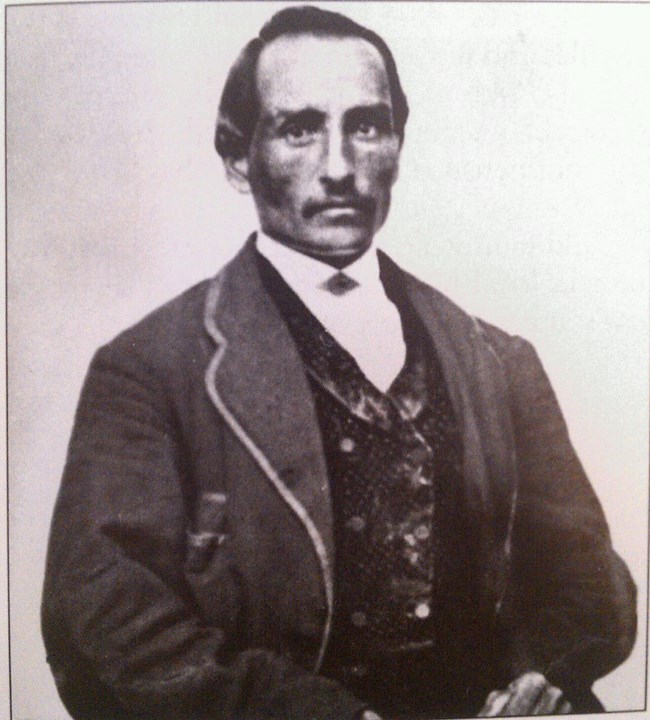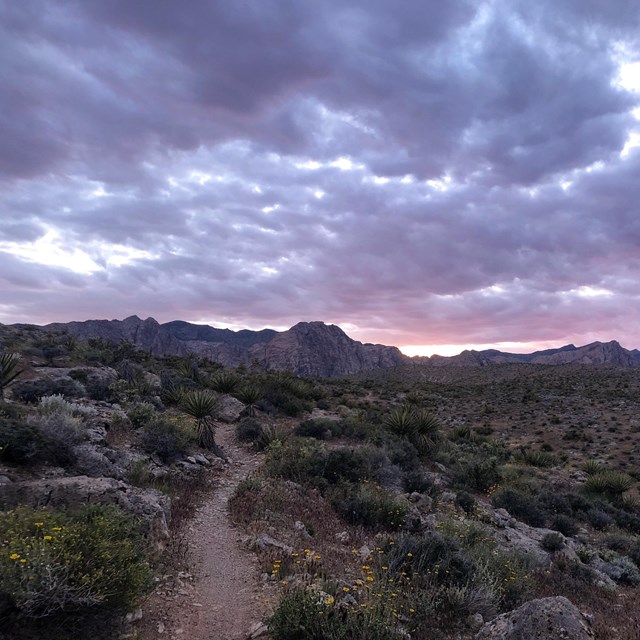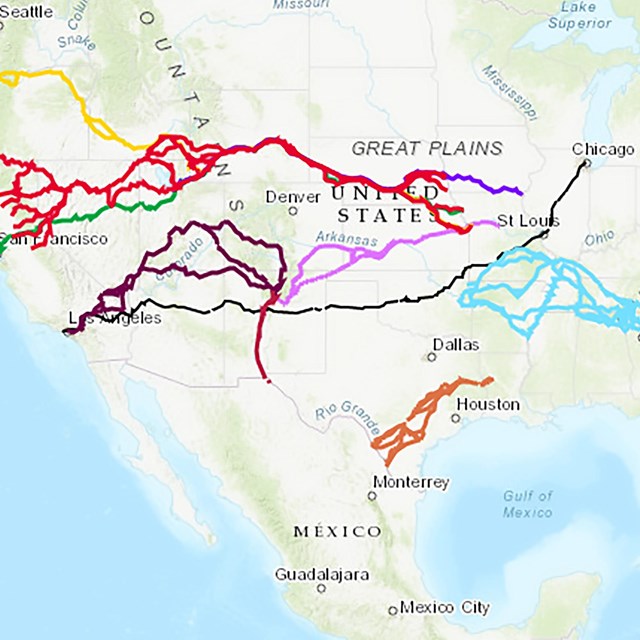Last updated: May 2, 2022
Article
Apolonia Vaca and Nestora Peña, the Old Spanish Trail

Image/Public Domain/Peña Adobe Historical Society
Apolonia Vaca and Nestora Peña – Old Spanish Trail[1]
By Angela Reiniche
In September of 1841, Apolonia Vaca and Nestora Peña, the youngest daughters in their respective families, traveled the Old Spanish Trail from Abiquiú, New Mexico, to California. Juan Felipe Peña and his wife, Ysabel Gonzales, also brought their five sons along; Apolonia Vaca had the company of her father, Juan Manuel Vaca, and seven siblings.[2] Apolonia’s mother had passed away earlier in the year, and five of her siblings had previously died in New Mexico. Many members of these families had already traveled the trails connecting California and New Mexico. The secularization of the mission system began in the mid-1830s, freeing countless acres for settlement by families like Apolonia’s and Nestora’s; thus, many who traveled the Old Spanish Trail were looking for land as well as trade.
The Rowland-Workman party, as this particular migrating party is now known, moved through northern New Mexico, across southwestern Colorado, through Utah, Nevada, and the Mojave Desert before reaching Los Angeles on 5 November 1841. Although no journey across the Old Spanish Trail could be described as ordinary, Apolonia and Nestora’s story is particularly noteworthy because they were just three and four years old, respectively. While most users of the Old Spanish Trail stopped in Los Angeles, the two young girls and the rest of their traveling companions continued northward to the far reaches of Alta California.
Because of their ages, it is unlikely that either of them could later recall the journey itself; nevertheless, the stories shared by older family members and other individuals in their party illuminate their experience. Apolonia and Nestora’s party contained more than their immediate families; they were joined by the Workman and Gordon families, two physicians, two coopers (barrel makers), three carpenters, a tailor, a musician, a gunsmith, a blacksmith, an engineer, a mineralogist, one naturalist, and Lorenzo Trujillo—a well-respected guide. The terrain was inhospitable to wagons so the party rode their horses or walked alongside their mules, on which they had loaded a few supplies and personal possessions.[3] According to family oral tradition, the young girls made the journey in a pair of saddlebags slung across the back of a mule.[4] Young enough to fit in the saddlebags, this conveyance allowed the girls to ride along, and the remainder of the party knew their whereabouts at all times.
Riding on either side of the mule, Nestora and Apolonia shared a singular vantage point and together received an education of sorts as the varied landscapes of Alta California unfolded before them. During short periods of rest, they witnessed the rituals of unpacking and repacking the mules and watched the party’s animals grazed nearby. The party brought sheep along to supplement any fish and game they could catch along the way. Water was plentiful until they reached the Mojave Desert; ominously, horse carcasses—perfectly preserved by the saline soil—marked the trail. More than two months after leaving Abiquiú on their mule, the young girls rode through Cajon Pass and, with the rest of their party, entered the coastal valleys of present-day California. Their journey, however, was far from over.[5]
After a two- to three-month rest, the Vaca and Peña families left Los Angeles in the late winter of 1842 for a 400-mile trek to the Suisun Valley in present-day northern California, where they had been promised land by General Mariano Vallejo. They stopped for shelter at Santa Barbara and Monterey before reaching Sonoma, where they met up with Vallejo. Nestora and Apolonia stayed behind at the mission with the other children and women; their fathers, however, continued onward to locate their chosen lands. The men built “wattle” houses to serve as temporary shelters while they constructed more permanent homes.[6]
Apolonia and Nestora’s fathers built their adobe homes less than two miles apart in the lush and breezy Laguna Valley and, by the summer of 1842, made an official petition for the 44,000 acre “Lihuaytos” grant. Mexican governor Manuel Micheltorena confirmed Vaca’s title to Rancho Lihuaytos in 1843 and, after resolving several boundary conflicts, Governor Pío Pico issued a grant two years later to both men for Rancho Los Putos (the grant’s new name).[7] The Peña family adobe became the first home on land that is presently in the city of Vacaville. Though their fathers had imagined that their large tracts would bring them prosperity, the everyday life that followed their arrival did not meet their expectations, as they struggled through legal battles with neighboring grantees and personal conflict divided their increasingly intertwined families. As the United States laid claim to California and gold-seekers began to squat on their lands, the Vaca and Peña landholdings started to diminish. The cattle for beef industry supplanted the hide and tallow trade. It was not until June of 1858, two years after Manuel Vaca’s death, that the U.S. Land Claims Commission recognized the continued, legally-adjudicated legitimacy of the grant at Rancho Los Putos.[8]
Apolonia married John Adamson in 1857, at about the age of 20, but was widowed early on and appears to have lived among various family members throughout the rest of her life in various parts of southern California.[9] Nestora inherited her father’s home and 1,000 acres of land when he died in 1863, and the land was converted from ranching to farming. The family prospered. Her mother continued to live there until her death in 1884, and Nestora stayed at the home until 1918, not long before her own death in 1922. Although it remained in the family for almost four more decades, the home was rarely occupied and had deteriorated considerably by the time they let it go in 1958. Restoration and preservation efforts began in the 1950s and continued in later decades. Today, the restored home is part of a park and museum complex that offers the curious traveler a glimpse into the everyday life on the Rancho during a time of significant change in the history of the California and Solano County from the perspective of early emigrants who arrived via the Old Spanish Trail.[10]
[1] Part of a 2016–2018 collaborative project of the National Trails- National Park Service and the University of New Mexico’s Department of History, “Student Experience in National Trails Historic Research: Vignettes Project” [Colorado Plateau Cooperative Ecosystem Studies Unit (CPCESU), Task Agreement P16AC00957]. This project was formulated to provide trail partners and the general public with useful biographies of less-studied trail figures—particularly African Americans, Hispanics, American Indians, women, and children. Thank you to the Old Spanish Trail Association for providing review of draft essays.
[2] Contemporary official records state that Juan Felipe Peña was also known as Juan Felipe Armijo; Ysabel Gonzales was also known as Isabella Gonsalves or Maria Ysabel Armijo. Because Juan Manuel Vaca could not write his name, his surname may well have been Baca.
[3] Jerry Bowen, “Vaca’s and Pena’s Lengthy Trek West,” Historical Articles of Solano County Online Database, 2 November 2003, http://www.solanoarticles.com/history/index.php/weblog/more/ vacas_and_penas_lengthy_trek_west/.
[4] See discussion of the saddlebag story in Kristin Delaplane, “Juan Manuel Vaca: The Don of Vacaville,” Historical Articles of Solano County Online Database, 12 March 1995, http://www.solanoarticles.com/history/index.php/weblog2/more/juan_manuel_vaca_the_don_of_vacaville/.
[5] Delaplane, “Juan Manuel Vaca: The Don of Vacaville.”
[6] Ibid.
[7] Bowen, “Vaca’s and Pena’s Lengthy Trek West.”
[8] David Vaught, “A Tale of Three Land Grants on the Northern California Borderlands,” Agricultural History 78, no. 2 (Spring 2004): 144–46.
[9] Marriage records reprinted by the Sacramento Bee show her marriage to Adamson at the Guadalupe Rancho in October of 1857.
[10] Cecilia Peña, “Maria Nestora (Peña) Rivera,” Old Spanish Trail Association, accessed 30 January 2020, https://oldspanishtrail.org/maria-nestora-pena-rivera; “About Us,” Peña Adobe Historical Society, accessed 30 January 2020, http://www.penaadobe.org/about.


